STYLES AND TYPES OF CLOSETS FOR YOUR REMODEL
Throughout NYC, storage space is a sought-after commodity. In apartments known to be comparable to the size of a closet, extra closet space is as valuable and as rare as gold. Despite this, there are still ways for you to make the most of the closet space you do have! And if your current closet simply won’t fit the bill, creating a new closet isn’t actually as complicated as you may have thought.
While custom closets in NYC are a hot real estate topic, understanding different types of closets can help you maximize the space you do have and create a closet that is efficient and looks beautiful! As experts in design, we at NYKB have taken some of our closet design knowledge and compiled it here. Read on for a better idea of what goes into designing a new closet, and how we can help you select the type of closet that suits your needs best!
DIFFERENT OPTIONS AND TYPES OF CLOSETS
With so many different types of closets to choose from, lets take a look at an overview of the most popular styles.
WALK-IN CLOSETS
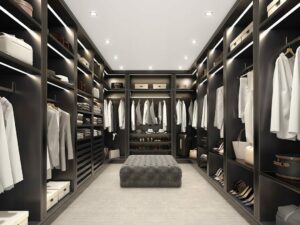

Luxury walk-in closets are the most desired types of custom closets, yet seldom in NYC are spaces large enough for these found. The closet can be a few square feet in area or as large as a room, and can be customized as per the need of the user. A walk-in closet can keep your clothes, shoes and other belongings organized. However, due to its function, a walk-in closet takes up more space than reach-in closets or wardrobes. With an array of storage mechanisms, a walk-in can sport pull-out accessories like a shirt pull-out or a trouser pull-out, drawers with dividers, jewelry storage, and more!
REACH-IN CLOSETS
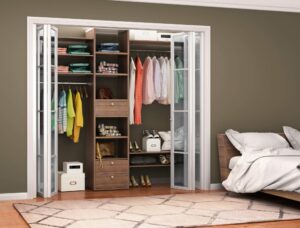

Reach-in closets are more typical of what you may find in New York City apartments. Though they are smaller than their walk-in closet cousins, with their width running anywhere between 3 to 8 feet, if organized and laid out well they can fit a lot of items. They are typically filled in with shelving and closet organizer systems on the back wall. Reach-in closets are perfect for combining various storage options like long bars for hanging clothes, and shelves and drawers for tucking away pants and shirts. This opens up the storage space and also helps with your home’s organization.
WARDROBES
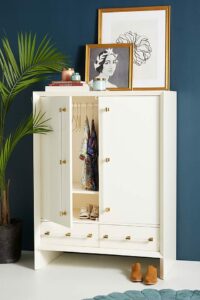

Unfortunately, some apartments in NYC don’t have enough space for multiple closets, forcing us to get creative with our storage solutions. Wardrobes and armoires are essentially pop-up reach-in closets that can be placed anywhere you need them. Wardrobes can be installed directly into the walls as built-in storage, or stand-alone units depending on what is best for your needs. This type of storage normally does not use doors; it is just open for easy access to reach your items (though if you prefer, it can have doors to hide any mess).
BASICS OF CLOSET DESIGN
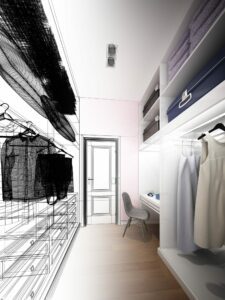

One of the most important objectives when considering custom closet designs is maximizing your storage space. This applies whether you are designing a walk-in closet, a reach-in closet, or even just a built-in wardrobe layoutConsidering what is going to be put into the closet, and how this closet is going to be utilized is key to choosing the right type of closet.
Customizing Your Closet
Here are some points to think about in advance of planning your customized closets.
Will you need shelves or pull out racks?
Do you keep your jewelry in the closet, will that need a space?
What materials do you want to use?
Coming up with a plan for all of these big questions upfront, will allow you to more easily navigate choosing a closet system (which we’ll discuss next).
The Closet vs The Room
It can be tempting, when installing or renovating your closet, to fill up an entire blank wall with closet space, but this may not necessarily be the best idea for the design of your overall room. As you are designing your closet, really think about how much space you need and will utilize.
Planning Your Closet Around Your Contents
Take stock of the items you want to include in the closet as you start to plan. Not only will this help you determine the overall size of your new closet, but it will also help you start grouping items into sections that can help with choosing your closet system! If, when hung, a particular clothes grouping (for example all of your sweaters that need to be hung) is 20” or more in width, it is advisable to plan for this group to have its own section in the closet.
Keep Your Closet User-Friendly
The final point of basic closet design that we’ll touch on, is to design ergonomically. This basically means that you want to design a closet that is as efficient and comfortable as possible for your needs. No one wants to have to bend down to put a bag away every day, or dig around for their winter coat. Not only will designing ergonomically help keep things organized and easily accessible, but it will keep your closet looking tidy and beautiful all year round!
CLOSET SYSTEMS
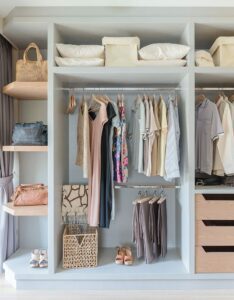

Now that you know the most common types of closets, and the basics of closet design, we can move onto the types of systems you can use to actually create a closet!
Hanging Sections
The first group of clothing to consider when laying out your closet is anything that needs a longer space to hang; robes, dresses, jumpsuits, long coats, etc.
- The rod for long hang sections should be hung 62”-70” from the floor, depending on your height, to give ample vertical space for longer clothing items.
- If long items are used less frequently, they can be hung in a corner, behind a door or other less accessible place.
- Most people do not need a lot of long hang space because their wardrobes primarily consist of two-piece or shorter items.
Next, and probably most common, is the double hang design, which is two short hang rods stacked over one another.
- How many double-hang sections your closet will need will depend on your wardrobe.
- The double-hang system is great for shirts, short jackets, folded pants, and blouses.
- For shorter, narrower items like folded pants and shirts, we’d recommend they go on the upper portion of this section because they will be easy to access, easy to see, and just have a cleaner look!
- Double hang systems should be hung anywhere from 42”-84” from the floor.
- You can add shelves above the double hang if you have very high ceilings to deal with and have selected a greater height for your closet.
Finally we’ll discuss medium hang sections.
- A medium hang section is generally hung right around the middle of the closet, around 60” from the floor.
- Generally you can hang anything that you would hang on a double hang section on a medium hang section – obviously not as much can fit as there is only one rod.
Any of these sections should have rods no longer than 36” to avoid compromising the integrity of the rod. If you do choose to install a longer closet rod, add in extra support brackets to prevent sagging and possible snapping!


Innovative Inserts
Specialty inserts like belt or tie pull outs can be super helpful and convenient if these are items that you use frequently or have a lot of. But sometimes, appealing gadgets don’t turn out to be worth the novelty. A good rule of thumb is, if a gadget involves more than one action to perform its role, you’ll probably grow tired of it.
Shelves
- While drawers will allow you to utilize the full depth of your closet, they do tend to be more expensive than open shelving and have a size limitation.
- Any shelves installed in your closet however should be installed with a purpose in mind. Whether it be for shoe storage, folded clothes, purses, or other items, everything should be planned out beforehand so no storage space goes to waste.
- Unless you have a very small or uniquely shaped closet where you need custom shelving, utilizing standard sized shelves that are 18”, 24”, or 30” wide will allow you to insert drawers or storage boxes eventually without much issue.
- When it comes to the depth of shelves, having shelves that are between 10”-14” will allow enough storage space while at the same time preventing items from becoming stuck at the back of the closet and too difficult to reach! This is particularly important when it comes to shelving above your clothing rods, and if done with careful attention it will make the need to reorganize your closet over and a thing of the past!
- Some closets have a rather large return wall, greater than 24”. You can absolutely utilize that awkward empty space by installing clothing rods or shelves that run the depth of the closet!
A Section For Shoes
If you have the space, and you want to include your shoes into your closet, we recommend installing shelving or drawers around mid-height so you can easily see and access them without having to constantly bend over.
Which Types Of Closets Suit Your Home?
Once you’ve determined which types of closets you need, everything that you’d like to fit into them, and you have figured out the most ideal sections and systems for your needs, it’s time to measure and get to work!
All of these tips are great for any DIYers that feel like taking on a closet overhaul themselves, but if you are looking for a professional touch, our designers are here to help. We have experience not only designing custom clothing closets, but can also help with installing new utility closets, and washer dryer closets. Contact NYKB to schedule your free consultation today!
With over 20 years of experience improving homes in New York, we at NYKB have what it takes to transform your home.

